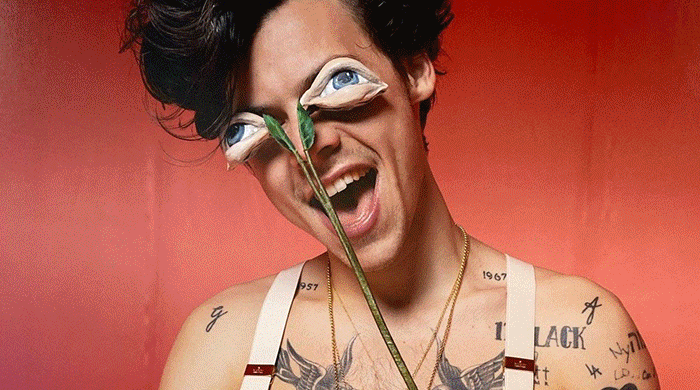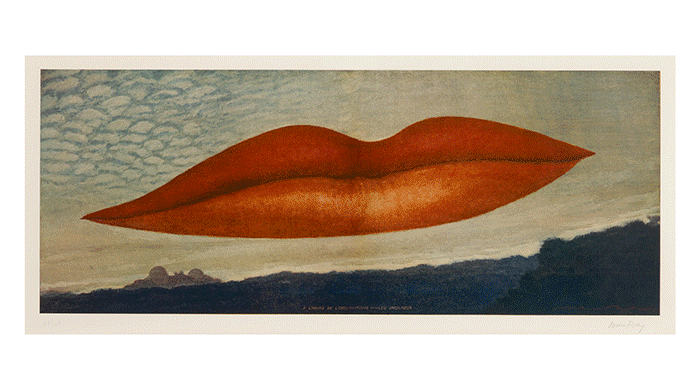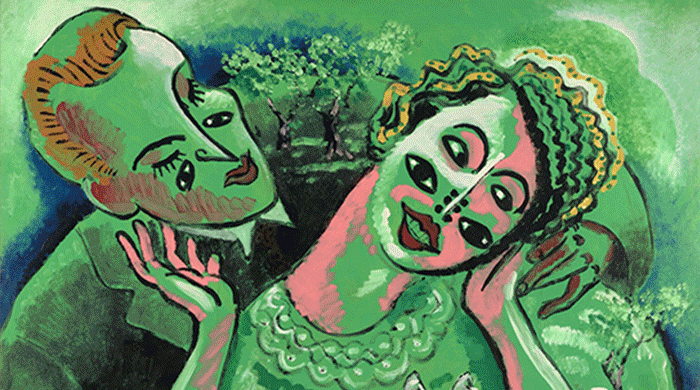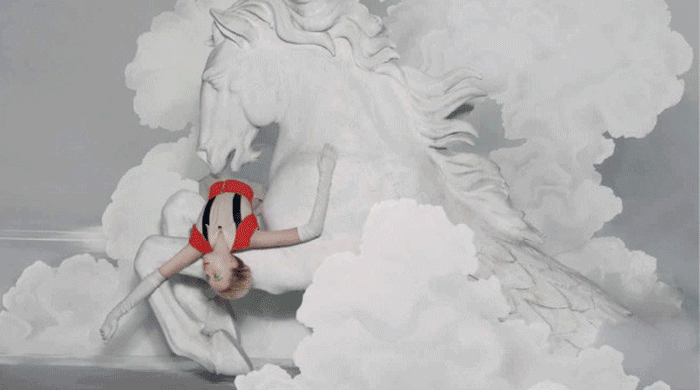Fashion's Love Affair with the Surreal
From Yves Saint Laurent to Virgil Abloh via Tim Walker and Shona Heath, fashion is closely intertwined with Surrealist values.
From Yves Saint Laurent to Virgil Abloh via Tim Walker and Shona Heath, fashion is closely intertwined with Surrealist values.
From Virgil Abloh’s catwalk at Louis Vuitton Menswear to John Galliano’s splash of colours at Maison Margiela, 2020 fashion has been flirting with the tropes of the Surrealist aesthetic, incorporating it into fashion collections, runway settings and photography. Even though Surrealism was invented in the twenties, it’s still highly influential 100 years later.
In fact, over the last century, fashion imagery has returned again and again to Surrealism as inspiration. The couture house Schiaparelli came to fame in the thirties for its links to Surrealism, and, far more recently, the photography and set design collaborations of Tim Walker and Shona Heath have incorporated the art form’s sensibilities. For over 20 years, Heath has staged the enchanting sets featured in Walker’s photography–itself highly Surrealist–and she has also been behind the space curation for the current Tim Walker exhibition at the V&A, which is filled with weird and wonderful sets.
Surrealism was birthed by the writer André Breton in 1924 when he published the Manifesto of Surrealism, and went on to be defined by artists such as Man Ray, Salvador Dali, Max Ernst, René Magritte and female pioneers like Dora Maar, Dorothea Tanning, Claude Cahun and Kay Sage. Unlike the artists of Dada, who rejected society’s capitalist values through absurdity in their work, the Surrealists aimed to tap into a dreamlike existence and explore the unconscious mind, following the work of psychoanalyst Sigmund Freud. The Surrealists' expression of dreams was carried out by staging symbolic objects in odd juxtapositions or abnormal sizes: for them, ordinary things could be used to create an unearthly universe.
It makes sense that fashion would be infatuated with Surrealism, as its mode of expression allows the imagination to flourish and expand beyond limitations. Forget seeing the sky as the limit: in Surrealism, self-expression becomes endless. Seeing the ordinary as symbolically potent feels particularly apt for fashion, in which small material tweaks can change the power of a garment from dowdy to daring. More practically, using everyday objects as motifs translates easily into other fabrics, materialise through jewellery shapes or haute couture techniques - taking fashion’s desire of creating ‘art pieces’ further.
Surrealism and fashion both heavily use metaphoric and symbolic messages: in both fields, the closer you look, the more you see. Both fields delight in stimulating emotional responses: remember Craig Green's S/S 15 solo debut collection, that brought viewers to tears with its beauty? Viewing a work whether by René Magritte or Alexander McQueen triggers an instant reaction whether it's discomfort, fascination or curiosity. Everybody engages with it, in one way or another, be it like or dislike.
So how can we see Surrealism in fashion? Shona Heath gave a talk at the V&A, to accompany the Tim Walker exhibition, that used her work as a lens through which to understand Surrealism’s enduring impact in a fashion space. Heath explored the art movement from the past to present, honing in on common motifs–the eye, the lips, colour and space experimentation–as keys to understand the Surrealist approach. It’s easy to see how they crop up repeatedly in fashion imagery.
The Eye
One of the most memorable characteristics of Surrealism is the motif of the eye. The eye is a representation of sight (and voyeurism): the eyes can also be seen as windows to the soul. When detailed onto clothing, as Yves Saint Laurent did on a midnight blue jacket in homage to Elsa Schiaparelli in his Autumn/Winter 1980 collection, eye motifs have a somewhat uneasy effect. The garment reverses your gaze: who is looking at who? Suddenly, the viewer is the one being observed and, perhaps, judged just as a fashion critic might do in viewing a garment. Salvador Dali’s painting The Eye (1945) also has a disturbing effect on the viewer, as the eye appears to be floating mid-air. When taking a closer look, it is as if the eye is formed out of the backdrop, and is one with the painting itself - reflecting and reversing the voyeurism of the artwork. The viewer becomes both observer and observed: fashion, too, loves to play with the relationship between wearer, viewer and garment.
Eyes are alluring, too: take Man Ray’s famous Les Larmes image, where an eye is framed by curled lashes with crystal tears. Eyes are integral to seduction, since eye contact is the first step to establish connection: there’s such a thing as love at first sight, after all. We know full well that fashion is often used to make oneself attractive, and to communicate something about the self inside. Dressing oneself is another tool of enticement, catching the attention, stimulating desire as well as expressing it. No wonder the eye–a gateway to interiority–is often taken up by fashion: fashion, too, is an external conduit to the soul of personality within.
The eye’s psychological connotations as gateway to the soul can be seen in modern cultural imagery produced by fashion makers. For Harry Styles’ 2019 Fine Line album artwork, Shona Heath teamed up with Tim Walker to tell the story through imagery of Styles’ desire to turn over a new leaf. Heath approached the project by using the eye as a symbol of the soul, disguising it as plants or flowers to further underscore Styles’ growth and new beginning.
The eye has become so emblematic of Surrealism that it has become a visual synecdoche for the movement itself. This was seen at the Schiaparelli haute couture Spring/Summer 2020 collection, when creative director Daniel Roseberry revived the eye-shaped brooch that artist and poet Jean Cocteau designed for the house in 1937. As fashion history scholars will know, the most significant and celebrated collaboration between fashion and Surrealism was fashion designer Elsa Schiaparelli’s involvement with artist Salvador Dali. From 1935 to 1941, in beautiful symbiosis, the two created a shoe-shaped hat, lobster dress and embroidered other Surreal motifs onto clothing.
The Lips
Man Ray enlarged his lover and muse Lee Miller’s lips in the oil painting Observatory Time - The Lovers (1934) following the end of their relationship two years prior. The picture is said to reflect the loss of a lover, the lips dominating the atmosphere, like clouds gathering on the horizon. And indeed he, like his fellow Surrealists, was fascinated with the sensual parts of the body, especially the lips, which have been symbolically linked to communicating, consuming and sexual congress. Fashion designers, too, have been spellbound by the possibilities that lips could play in their designs, often focusing on the more serious or adult connotations that the symbol holds.
Inspired by forties wartime fashion, Yves Saint Laurent gave the lips a darker interpretation in his scandalous 1971 Libération haute couture collection. Among the designs, a dress was embroidered with several lip motifs, which he said symbolised the women who formed relationships with Nazi soldiers during the occupation and afterwards received public humiliation and punishment. The sexual and negative connotations that the dress embodied shocked its audience alongside the rest of the collection, which harked back to wartime France. For Saint Laurent, the romantic symbol of the lips was here associated with morality and shame.
In another controversial collection, Alexander McQueen’s Autumn/Winter 2009 offering, entitled The Horn of Plenty, models' lips were blown out of proportion by red and black lipstick. The models' exaggerated lips took inspiration from performance artist Leigh Bowery who delighted in the theatrics of the grotesque: McQueen's show make-up served as caricature of womanhood, drawing attention to the fine line between appropriate grooming and monstrous face painting. Lipstick is alluring up until it spills over the boundaries of the lip line; lipstick around the mouth is considered ugly, and thus, terrifying.
McQueen's super-sizing of models' lips exaggerated the sexual connotations of the mouth, transforming the painted lips' appeal from subconscious allure to more explicit fetishism. It would be remiss not to mention the resemblance of lips to female genitalia, which was a common strand of Sigmund Freud and Karl Abraham's work: the psychoanalysts–whose work was widely circulated prior to Surrealism's birth–believed mouths and vaginas were connected in sexual development. The Surrealists were highly influenced by Freud, particularly his dream theory, in which dreams are seen as a way of unlocking the unconscious mind. For Freud, the content of dreams, far from being a set of random images, represents hidden situations or feelings related to the waking world.
It's this fascination with multiple meanings, particularly erotic or taboo ones, that fashion seems to enjoy experimenting with. As with McQueen, we see the optical illusion of 'lips or vulva' play out in Shona Heath and Tim Walker’s work too, most specifically in a heavily Surrealism-inflected shoot for LOVE magazine's Spring/Summer 2016 issue. At Heath’s panel discussion, she talked through how she had created conch shells for the set, whose pinkness and proportions echoed labia. Amongst the final images, the model Anna Cleveland is practically nude and she is seen squatting legs akimbo, one hand gesturing to her own genitalia, the other gently caressing one of Heath's shells.
From Man Ray to Shona Heath, the portrayal and reiteration of the lips creates a visible connection to female sexuality and all that envelops. The lips live simultaneously as object of titillation and as deep unconscious metaphor for sex and womanhood and the body. To fashion, the lips' multivalence makes them significant for exploring, experimenting with and empowering femininity.
The Avant Garde Use of Color
Colour is another important aspect of Surrealism: it was used to create a shock effect by applying it in new explorational ways, like painting green on a face in Francis Picabia’s Sous les oliviers (painted 1924-27). The stark green colour almost takes over the entire picture, as it's used on both clothes, faces and background. This was unusual for that time, when paintings typically depicted people in their natural light.
For the Surrealists, an unexpected colour breaks convention and expectations, and as such, creates room for experimentation and excitement. Colour is used in much the same way in fashion: the shock effect of unusual colour is a useful tool for designers to catch the eye and create a sense of newness, thus attracting attention and continue reaching their consumer bases. The 1957 romantic comedy film Funny Face has a musical number spoofing high fashion magazines: the editor, played by Kay Thompson, dictates that readers must 'think pink,' and 'banish the black, burn the blue, and bury the beige': it is apparent that novelty can be created through switching up colours - something designers make the most of, to great effect.
Recently, Maison Margiela Artisanal staged its Spring/Summer 2020 haute couture show in a room painted hot pink from floor to ceiling. Models stepped out in a splash of colours, look after look. A royal blue dress was accessorised with flashy red gloves, turquoise lipstick. A lilac hat was styled with a green coat, pink gloves and red veil. All in all, it was an endless mix of joyful colours that, together with the collaged, distorted and recut silhouettes on dresses and coats, brought an avant garde air to proceedings.
To Margiela creative director John Galliano, it was about creating suspense through colour, and he used layers of fabric to enhance or change a shade's depth and intensity. ‘With some of the dresses, we have increased the volume at the bottom of the overdress. [There] is silk tulle over [the top], and it’s so fine, that when it falls over itself, it’s like an aquarelle of colour that leads up the body. [The] colour becomes its most intense when that tulle falls. It really is like painting, but with fabric,’ he explained on the Maison Margiela podcast. The dynamic combinations on the runway made it impossible to look away or feel the clothes' optimism: just like Picabia’s stark green face stops the art viewer in its tracks.
Similarly to the Surrealists' disruptive approach to colour, Yves Saint Laurent, too, would create colour combinations that defied taste conventions, in the process expanding how colour could be perceived. In his eighties collections, he was known to test colours out against each other, putting them together in ways that may have been considered unflattering in the hands of another designer, yet on the runway they were supremely eye-catching. The master couturier would combine a fuchsia silk blouse with an orange pencil skirt and blazer, topped with a violet hat, or wrap a bright yellow bow around a pair of cobalt blue shorts and purple shirt. ‘He put things together that didn’t belong together and made them look like the newest, most modern thing,’ fashion commentator Tim Blanks explained in a YouTube video for Style.com.
Shona Heath approaches colour in similar ways, noting at her talk: ‘Colour is an important part of my work. I find the right colour combinations by testing them, and often I figure it out by seeing what would look worse with what.’ The immediate unexpected response that two colours can evoke as soon as they are put together feels highly related to Surrealism's intention to shock and intrigue.
The selection of a colour itself can be replete with meaning. For the Surrealist LOVE magazine photoshoot, Heath created a blush pink coloured castle that led the mind back to fairy tales, carefree days and pure utopia. ‘I instantly knew I wanted to make a pink castle. By having the colour it has, I think the castle creates this nostalgia of childhood and the idea of dreaming,’ she said. Indeed, when you try imagining said fairytale castle in either blue or green, the link to childhood is weakened.
The association of pale pink and childhood brings up another Surrealist value, again borrowed from Freud. Freud believed childhood experiences affected behaviour in adulthood, and, as such, an understanding of one's childhood could provide a map for the adult subconscious. Surrealism, in its playful use of domestic objects and gaudy colour, celebrated the purity of childhood imagination, as does Heath's use of blushy pink on the castle: the colour creates a sense of innocence and lost time by appearing delicate and tender. It is an example of how colour stimulates and plays with our imagination to make us stop, pause and reflect.
The Infinite Space
Playing with the idea of space itself was another key fascination for Surrealists. Kay Sage used the positions of objects in her work to call into question where a space would begin and end, and her husband Yves Tanguy blurred the horizontal line in his paintings, to make them seem empty and endless. In Surrealist thinking, space becomes a backdrop for endless possibilities, and the foundation for a dreamlike existence - a beautiful questioning of illusion and truth. Fashion and the spectacle of its catwalk shows, too, becomes a space of infinite dreaming: fashion, too, calls into question how we see reality and artifice.
For Louis Vuitton Autumn/Winter 2020 Menswear, creative director Virgil Abloh staged a seemingly infinite space, as if up in the clouds, for his runway. The fashion industry found itself in a Surreal and childlike landscape: blue sky and clouds covered walls and floor. The scenery felt as if you were looking at the world through a child’s eyes, with naive optimism, free of self-limitation. The space felt liberating, but at the same time reminded you to question what is real and what isn’t in the world. Why does the illusion of infinite space have such a powerful effect on the psyche? Which obstacles to clear thinking might, in truth, be imaginary? What role can dreaming have? Where can dreaming begin and end? And how does that shift as you move through life?
The creation of seemingly infinite space, of course, is an optical illusion. Heath explained that she makes the most of visual trickery, noting that she fills her sets with props, placing them within the camera frame to create an unlimited spatial effect. For British Vogue’s December 2010 issue, Heath was tasked with creating a zodiac-themed heavenly world. For that she turned to clouds, a fascination of hers, to create the feeling of a void space that reaches beyond limitation. She added white outlines to the bottom of the cloud props she made, so they would appear as if floating and fast moving, and drizzled salt (from Tesco) outwards in a thin line, to further amplify the feeling of infinite space. The use of the quotidian to create confounding exceptional experiences is certainly something of which the Surrealists would have approved.
Clouds feature in paintings by René Magritte like Decalcomania (1966), The Great Family (1963) and The False Mirror (1929). Magritte would paint the clouds as a backdrop for the scenery, yet they would still take centre stage by becoming part of the objects - just like in Abloh’s Louis Vuitton show where the cloud backdrop also appeared, splashed all over suits. Reading symbolic meaning into the collection, as any good Surrealist would have us do, we can see clouds as a representation of air and, subsequently, clear thinking, emotional purity and dreams. Given that the industry might be perceived by most as a materialistic and ego-driven bubble, the incorporation of clouds revives a sense of naivety and pure intention, reminding the viewer of why they decided to be part of the industry in the first place. Abloh has centred his recent Vuitton collections around the idea of playfulness and joy. At least for him, a lighter and more playful mood in fashion is important.
The creation of a world that seems so distant from reality yet consists of the most mundane materials from daily life is captivating in its imaginative potential. The same goes for a Surrealistic artwork. The juxtaposition of known objects that we encounter in life–a watch, a teardrop, an elephant, a person, a bird, a mountain, a butterfly–reassembled in abnormal forms and perspectives create a new dimension to our reality. When a space looks like it will continue forever and no physical law seems to exist, it allows us to question the current set of rules in which we operate, in the same way that fashion, in altering the smallest of details, can create new modes of being and experiencing. Surrealism centred around creating states of mind where unfettered playfulness and intuition can thrive: something fashion could do with, most definitely. While the 2020 collections serve as proof that both the visual cues and the underlying values of Surrealism still find a perfect spiritual home in fashion, even a century later: it's clear there's still lots of Surrealist material for fashion to explore.




